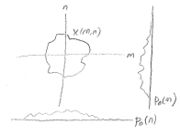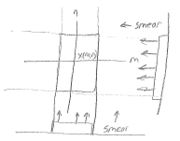| Line 106: | Line 106: | ||
b) Derive an expression <span class="texhtml">''P''<sub>0</sub>(''e''<sup>''j''ω</sup>)</span> in terms of <span class="texhtml">''X''(''e''<sup>''j''μ</sup>,''e''<sup>''j''ν</sup>)</span>. | b) Derive an expression <span class="texhtml">''P''<sub>0</sub>(''e''<sup>''j''ω</sup>)</span> in terms of <span class="texhtml">''X''(''e''<sup>''j''μ</sup>,''e''<sup>''j''ν</sup>)</span>. | ||
| − | c) | + | c) Find a function x(m,n) that is not zero everywhere such that <math>{{p}_{0}}(n)={{p}_{1}}(m)=0</math> for all m and n. |
| − | d) Do the function <span class="texhtml">''p''<sub>0</sub>(''n'')</span> and <span class="texhtml">''p''<sub>1</sub>(''m'')</span> together | + | d) Do the function <span class="texhtml">''p''<sub>0</sub>(''n'')</span> and <span class="texhtml">''p''<sub>1</sub>(''m'')</span> together contain sufficient information to uniquely reconstruct the function <span class="texhtml">''x''(''m'',''n'')</span>? Justify your answer. |
| − | (Refer to | + | (Refer to <u>[https://engineering.purdue.edu/~bouman/ece637/previous/ece637S2015/exams/exam1/exam.pdf ECE 637 Spring 2015 Exam 1 Problem 2].</u>) |
---- | ---- | ||
Revision as of 13:35, 2 May 2017
Communication Networks Signal and Image processing (CS)
Problem 1,2
Solution 1:
a) $ {{P}_{0}}({{e}^{j\omega }})=\sum\limits_{n=-\infty }^{\infty }{{{p}_{0}}(n){{e}^{-jn\omega }}}=\sum\limits_{n=-\infty }^{\infty }{\left( \sum\limits_{m=-\infty }^{\infty }{x(m,n)} \right){{e}^{-jn\omega }}}=\sum\limits_{m=-\infty }^{\infty }{\sum\limits_{n=-\infty }^{\infty }{x(m,n)}{{e}^{-j(m0+n\omega )}}=X({{e}^{j0}},{{e}^{j\omega }})} $
b) $ {{P}_{1}}({{e}^{j\omega }})=\sum\limits_{m=-\infty }^{\infty }{{{p}_{1}}(m){{e}^{-jm\omega }}}=\sum\limits_{m=-\infty }^{\infty }{\left( \sum\limits_{n=-\infty }^{\infty }{x(m,n)} \right){{e}^{-jm\omega }}}=\sum\limits_{m=-\infty }^{\infty }{\sum\limits_{n=-\infty }^{\infty }{x(m,n)}{{e}^{-j(m\omega +n0)}}=X({{e}^{j\omega }},{{e}^{j0}})} $
The solution used $ v $ and $ \mu $ to represent frequency axis. It used $ w $ to subuslitude both $ v $ and $ \mu $ which is confusing. The solution should stated let $ w=v $ and $ w=\mu $ at (a) and (b).
c)
$ \sum\limits_{n=-\infty }^{\infty }{{{p}_{0}}(n)}==\sum\limits_{n=-\infty }^{\infty }{\left( \sum\limits_{m=-\infty }^{\infty }{x(m,n)} \right)}=\sum\limits_{m=-\infty }^{\infty }{\sum\limits_{n=-\infty }^{\infty }{x(m,n)}{{e}^{-j(m0+n0)}}=X({{e}^{j0}},{{e}^{j0}})} $
d) No, they don’t. From part (a) and (b), we know that $ {{P}_{0}}({{e}^{jw}}) $ and $ {{P}_{1}}({{e}^{jw}}) $ represent the horizontal and vertical axes of the 2D DSFT $ X({{e}^{j\mu }},{{e}^{j\upsilon }}) $, which is not enough for reconstruction of x(m, n). For example, $ {{x}_{1}}(m,n)=\left( \begin{matrix} 1 & 3 \\ 2 & 4 \\ \end{matrix} \right),_{{}}^{{}}and_{{}}^{{}}{{x}_{2}}(m,n)=\left( \begin{matrix} 0 & 4 \\ 3 & 3 \\ \end{matrix} \right) $ have the same $ {{p}_{0}}(n)=\left[ \begin{matrix} 3 & 7 \\ \end{matrix} \right]_{{}}^{{}}and_{{}}^{{}}{{p}_{1}}(m)=\left[ \begin{matrix} 4 \\ 6 \\ \end{matrix} \right] $. So, x(m,n) can’t be reconstructed from $ {{p}_{0}}(n)=\left[ \begin{matrix} 3 & 7 \\ \end{matrix} \right]_{{}}^{{}}and_{{}}^{{}}{{p}_{1}}(m)=\left[ \begin{matrix} 4 \\ 6 \\ \end{matrix} \right] $.
Solution 2:
a) $ {{P}_{0}}({{e}^{j\omega }})=\sum\limits_{n=-\infty }^{\infty }{\sum\limits_{m=-\infty }^{\infty }{x(m,n)} {{e}^{-jn\omega }}}=X({{e}^{j0}},{{e}^{j\omega }}) $
b) $ {{P}_{1}}({{e}^{j\omega }})=\sum\limits_{m=-\infty }^{\infty }{\sum\limits_{n=-\infty }^{\infty }{x(m,n)}{{e}^{-jm\omega }}}=X({{e}^{j\omega }},{{e}^{j0}}) $
To be consistent with the problem statement, frequency notation$ \mu $ corresponds to the spatial notation $ m $ and is the first parameter. As a result, the solution of the (a) and (b) can be switched.
c) They do not; $ {{p}_{0}}(n)\ and\ {{p}_{1}}(m) $ are projections at two angles, and do not contain enough information to reconstruct x(m,n).
$ \begin{align} & X({{e}^{j\mu }},{{e}^{j\upsilon }})=\sum\limits_{m=-\infty }^{\infty }{\left[ \sum\limits_{n=-\infty }^{\infty }{x(m,n)} \right]}{{e}^{-jm\mu }}{{e}^{-jn\upsilon }} \\ & X({{e}^{j\mu }},{{e}^{j\upsilon }})\ne \sum\limits_{m=-\infty }^{\infty }{{{p}_{1}}(m)}{{e}^{-jm\mu }}{{e}^{-jn\upsilon }}\ne {{P}_{1}}({{e}^{j\mu }}){{e}^{-jn\upsilon }} \\ & \Rightarrow Can't\ do\ it! \end{align} $
- To form reconstruction, need projections along many angles.
- Could reconstruct a very simple object, like triangle.
Related Problem
Consider the 2D discrete space signal x(m,n) with the DSFT of X(ejμ,ejν) given by
$ X(e^{j\mu},e^{j\nu}) = \sum_{m=-\infty}^{\infty} \sum_{n=-\infty}^{\infty} x(m,n)e^{-j(m\mu+n\nu)} $
Then define
$ p_{0}(n) = \sum_{m=-\infty}^{\infty}x(m,n) $
$ p_{1}(m) = \sum_{n=-\infty}^{\infty}x(m,n) $
with corresponding DTFT given by
$ P_{0}(e^{j\omega}) = \sum_{n=-\infty}^{\infty} p_{0}(n)e^{-jn\omega} $
$ P_{1}(e^{j\omega}) = \sum_{m=-\infty}^{\infty} p_{0}(m)e^{-jm\omega} $
a) Derive an expression for P0(ejω) in terms of X(ejμ,wjν).
b) Derive an expression P0(ejω) in terms of X(ejμ,ejν).
c) Find a function x(m,n) that is not zero everywhere such that $ {{p}_{0}}(n)={{p}_{1}}(m)=0 $ for all m and n.
d) Do the function p0(n) and p1(m) together contain sufficient information to uniquely reconstruct the function x(m,n)? Justify your answer.
(Refer to ECE 637 Spring 2015 Exam 1 Problem 2.)



